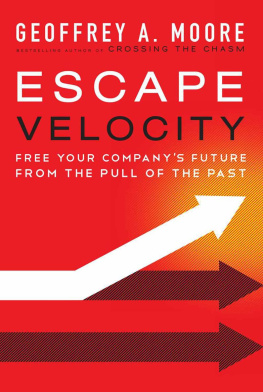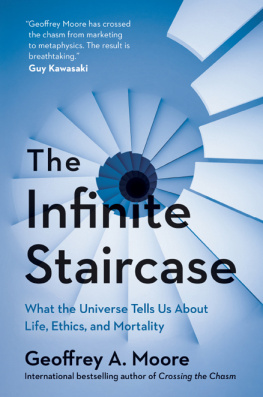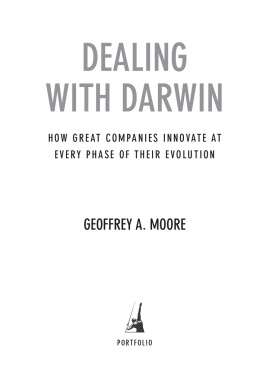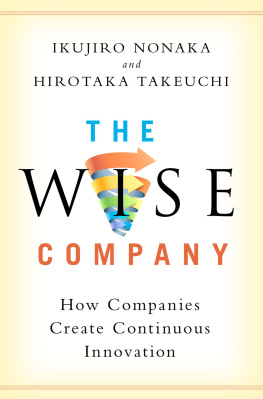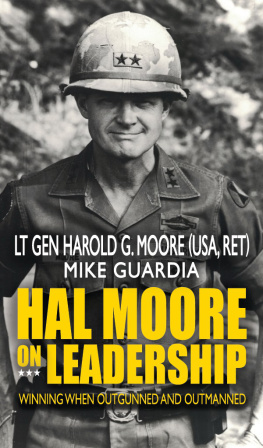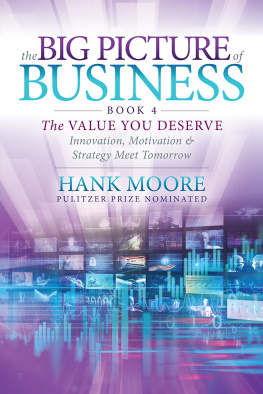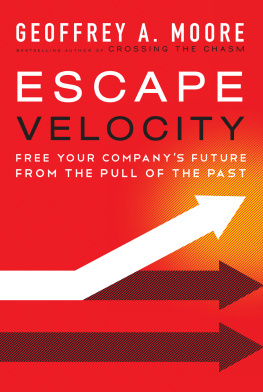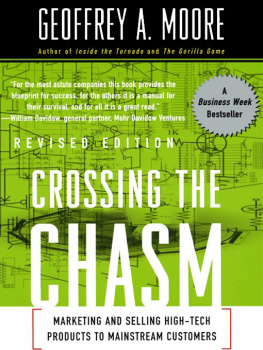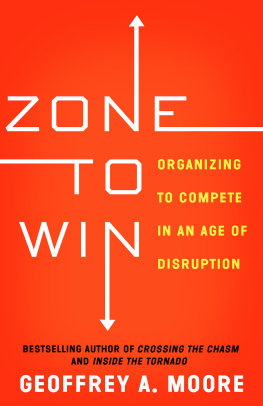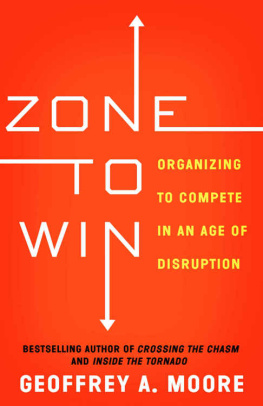Escape Velocity
Free Your Companys Future from the Pull of the Past
GEOFFREY A. MOORE

To Pat Granger,
who manages my context so that I may focus on core
and who has become a good friend and trusted adviser
Contents
T his is a book about freeing your companys future from the pull of the past, but we should ask ourselves right from the start, why should one believe it is in need of liberation? Whats the matter with the status quo? Why isnt Steady as she goes the mantra of choice, or perhaps Stay the course? What change is so dramatic that it calls into question the working assumptions that have sustained successful business performance for the past half century? In a word: globalization .
For all my life enterprises hosted in the United States, Western Europe, and Japan have had home field advantage in the great growth markets of the twentieth century, with privileged access in particular to the American consumer economy. This is our proud past, and its pull is palpable. In the twenty-first century, however, we can already see that these advantages no longer obtain. The American consumer is as readily accessed from Singapore as Seattle, and the great growth market opportunities will come from the developing, not the developed, economies. Of the next 1.3 billion people to be added to the world population, only 90 million are expected to come from developed-economy countries. This means the current set of global enterprise leaders will have to develop new skills for playing away games or see their power marginalized.
At the same time, the first generation of successful enterprises coming out of the developing world also need to reorient themselves to their future, leaving behind a past in which their growth came primarily from penetrating mature markets with lower-cost offers. As their standards of living rise, their cost advantages decline, and playing a game where partners and customers lead and they follow will no longer serve. They themselves must take the lead or again be content to see their power marginalized. One way or another, for everyone involved, globalization means a whole new ball game.
And that means back to the drawing board for vision, strategy, and execution. What, to begin with, do we think this new world will actually want from developed-economy companies? What will it want from IBM? Apple? Google? Microsoft? HP? Dell? More of the same? Well, yes, to some extentbut what else? And what else will it want from your company?
Posing that question unlocks a whole storehouse of questions to follow. Which markets will create your best returns, and how will you realign your management and resources to capitalize on them? Who will design your next generation of offers, and for whom will they be designed? Who are becoming your new reference competitors, and how do you stack up against the norms they are setting? On what basis will you be able to differentiate against these competitors sustainably? And how will your legacy business models stand up in an increasingly digitized, globalized, and virtualized economy? These are vexing questions indeed.
Now, to be sure, the forces we are invoking will take time to unfold. The sky is not fallingyet. There is still plenty of opportunity to read and react, to listen and evolve. If you can make reasonable and steady progress toward staking out positions in next-generation markets, while at the same time leveraging your current positions in current markets, you can be optimistic about your chances. Or can you?
What if there is some hidden force that is working against your best efforts? What if this force is operating inside your own company, with the full support of your executive team, your board of directors, your investors, and indeed yourself? What if this force is able to mysteriously redirect resource allocation so that it never quite gets deployed against the new agendas?
That force, I submit, is the pull of the past, most concretely embodied in your prior years operating plan. That plan exerts a gravitational force that pulls inexorably at any investments that seek to depart from its inertial path. The larger and more successful the enterprise, the greater the inertial mass, the harder it is to alter course and speed.
This observation may seem commonplace, so let us just take a minute to call to mind how deep these ruts can run.
You are on an annual calendar, and strategic planning begins, say, sometime in Q3 and comes to a close at the end of Q4. How does the process begin? Typically with the CFO circulating last years operating plan as a benchmark for setting next years resource allocation and performance goals. (Just take your fourth-quarter numbers and multiply them by four for a start.) By the way, this is a perfectly acceptable procedure for mature markets with cyclical growth patterns where market shares shift by a small percentage in any given year.
What happens next? The executive staff asks all the participating units to draft a bottoms-up plan for next year while, in tandem, it develops a top-down set of goals and benchmarks. These two efforts converge to shake hands early in the fourth quarter, only to confirm that their positions are so far apart they can barely see each other to wave across the table. From this inauspicious beginning, an extended exercise in stretching and cutting, putting and taking ensues, which takes on the air of something between a late-night poker game and a ritual fire dance. You might call it the ultimate zero-sum game except that it really pursues a minus-sum target, a do-more-with-less result. In any event, it is conducted with all the goodwill and trustworthiness of a used-car sale negotiation, perhaps its greatest virtue being that it makes executives anxious to get back into execution mode.
But again, let me be clear: this is standard operating procedure for squeezing operational gains from mature markets, and to the degree that your enterprise is an established player in such venues, there is nothing inherently wrong with it. OK, it could be done with better grace and less waste of energy, but it does not result, in and of itself, in bad economic results. Until you expose the enterprise to secular market change.
Secular growth , in this context, means a not to be repeated expansion of the market that occurs whenever a new category or a new class of customers is brought on board. It stands in contrast to cyclical growth , which refers to the ongoing returns from an established market, one in which the customers and the category remain the same and power shuttles here and there among various vendors and their latest offers. The key point here is, you can make a mistake with cyclical growth and still have plenty of chances to get yourself back in the game. That is not the case, however, with secular change. Whiff here, and you miss out on a massive growth opportunity that will never pass your way again. In short, missing out on secular growth is a disaster.
But that is precisely what you are about to do. All the resource decision making you and your colleagues are engaging in, after all, is internally focused. It gets resolved not in relation to market opportunity but rather in relation to other players on the same teamI got the head count or you did, and whichever one of us it was, we sure as heck arent giving it back. Which means when it comes to strategy dialogues, we have to justify the resources we have managed to secure no matter what. So we tell strategy stories that have all the authenticity of political advertisements and that collectively add up to a vision so self-centered and self-serving as to be incommunicable outside our immediate ranks. Meanwhile, the entire world is yelling at us that a train is coming, which doesnt help, because we know a train is coming, but we are locked into relationships that do not allow any of us to move off the track. In short, we are not stupid, and we are not unaware, we are just well and truly stuck.
Next page
